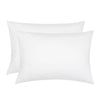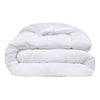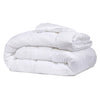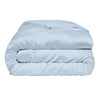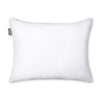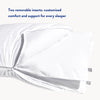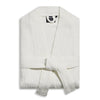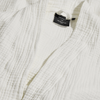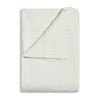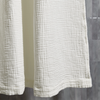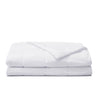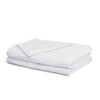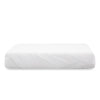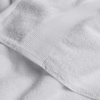The Daily Miracle
What Are Microfiber Sheets: Everything You Need To Know
Published
June 19, 2025
Author
John Tsenekos

Bedding is one of the most confusing things in the world. The fact is, most people simply don't know enough about bedding to make an informed choice. This is why, when it comes to purchasing new bedding, people opt for the most cost-effective option that sounds kind of nice. This usually means low-thread-count cotton sheets or polycotton blend sheets. Silk is luxury, so people who opt for silk or satin sheets want a particular feel and are willing to pay a premium for it. But there's another option that's trending in the market right now, and for all the right reasons, too: microfiber sheets.
With big promises of softness, durability, and easy care, it’s no surprise shoppers are curious about what microfiber sheets really are and if they deserve the hype. In this guide, we have discussed everything you need to know about microfiber sheets: their materials, benefits, drawbacks, and care tips.
What Are Microfiber Sheets?
Microfiber sheets have earned a solid reputation for being soft, affordable, and durable. Made from ultra-fine synthetic materials like polyester and nylon, they’re wrinkle-resistant and easy to care for, no endless ironing required. While microfiber doesn’t breathe as well as cotton sheets, it’s perfect if you want low-maintenance, budget-friendly bedding with a smooth, soft feel. The tight weave makes these sheets lightweight and helps them resist wrinkles, so your bed stays neat with minimal effort. Microfiber also doesn’t soak up moisture easily and features moisture-wicking properties, making it a smart option for warmer sleepers. If you’re looking for comfort and value, microfiber sheets are a popular choice that delivers on both.
What Are the Benefits of Microfiber Bedding?
-
Exceptional Softness: Microfiber sheets feel amazingly soft, often likened to silk or satin. They provide a luxurious, cozy feel against your skin, helping you drift off to a comfortable night's sleep.
-
Durability & Wrinkle Resistance: These synthetic fibers are tough, meaning microfiber sheets stand up well to wear and tear. They're also wrinkle-resistant, which keeps them looking fresh without constant ironing.
-
Affordability: Compared to pricier options like cotton, linen, or silk, microfiber sheets are usually much more affordable, offering luxury at a fraction of the cost.
-
Low Maintenance: With microfiber, caring for your bedding is a breeze. They're machine washable, quick to dry, and save time and energy in your laundry routine.
-
Hypoallergenic Properties: The tight weave naturally repels dust mites and allergens, making these sheets a great pick for anyone with allergies or sensitive skin.
How Are Microfiber Sheets Different From Cotton Sheets?
Microfiber and cotton sheets differ in a few key ways, especially when it comes to feel, composition, performance, and moisture-wicking properties. Cotton is a natural, breathable fiber that absorbs moisture easily, making it ideal for hot sleepers or warm climates. Microfiber, on the other hand, is synthetic and less breathable, which can lead to heat retention. However, microfiber is smoother, resists wrinkles better, and stays consistent in texture over time. Cotton becomes softer with every wash, while microfiber maintains its original feel. Microfiber also tends to cost less, which makes it appealing for budget-conscious shoppers.
Which Is Better, Cotton or Microfiber Sheets?
Choosing between cotton and microfiber sheets comes down to your personal preferences and priorities. Cotton sheets are known for their natural breathability and classic feel. They’re a great choice if you love crisp, cool bedding and want sheets that get softer with every wash. Cotton is also a natural fiber, which appeals to those who prefer more traditional or eco-friendly options.
Microfiber sheets, on the other hand, are made from ultra-fine synthetic fibers like polyester and nylon. They’re incredibly soft right out of the package, lightweight, and resistant to wrinkles, so your bed always looks neat with minimal effort. Microfiber is also more affordable and easier to care for, making it a smart pick if you want low-maintenance, budget-friendly bedding.
If you tend to sleep hot, cotton sheets’ breathability might be more comfortable for you. But if you want sheets that are soft, durable, and easy to keep looking fresh, microfiber could be a better fit. Ultimately, both options have their strengths, so the best choice depends on what matters most to you in your bedding.
Are Microfiber Sheets a Good Choice for People With Allergies?
Yes, microfiber sheets are often a top choice for allergy sufferers. Their tightly woven fibers act as a natural barrier, keeping out common allergens like dust mites, pollen, and pet dander. This helps reduce the likelihood of irritants settling in your bedding. Compared to cotton sheets, which can absorb and hold onto allergens, microfiber creates an unfriendly environment for dust mites. Just remember to wash your sheets regularly to remove any surface allergens and maximize their hypoallergenic benefits.
Can Microfiber Sheets Help Regulate Body Temperature While You Sleep?
Microfiber sheets can help with temperature regulation to some degree, but they won’t perform like natural fibers. Unlike cotton, which allows for more airflow, microfiber’s tighter weave can trap heat. That said, microfiber's moisture-wicking structure may prevent a clammy feeling. Some microfiber sheets are designed with enhanced breathability, making them a cozy choice for cold sleepers. If you tend to get too warm at night, look for lightweight microfiber options.
Are Microfiber Sheets Healthy to Sleep On?
Yes, microfiber sheets are generally healthy to sleep on for most people. They’re made from tightly woven synthetic fibers, which ensures a high level of cleanliness as they naturally resist dust, dirt, and allergens better than many traditional fabrics. This makes microfiber a great option if you’re looking for bedding that helps keep your sleep environment cleaner.
Microfiber sheets are also soft and gentle on your skin, providing a comfortable surface to rest on night after night. If you have sensitive skin or allergies, look for microfiber sheets labeled as hypoallergenic for extra peace of mind.
To keep your microfiber sheets fresh and healthy, it’s important to wash them regularly with a mild detergent. This helps remove any buildup of sweat, oils, or allergens, so you can enjoy a clean and comfortable bed every night.
How Do You Properly Care for Microfiber Sheets to Extend Their Lifespan?
Taking care of your microfiber sheets is simple but important if you want them to last.
-
Machine wash in cold water with a mild detergent, avoiding bleach or harsh chemicals that could damage the fibers.
-
Use low heat if you’re tumble-drying or let them air dry to prevent shrinkage or breakdown.
-
Skip the fabric softeners since they can clog the fibers, reducing softness and breathability.
-
Wash your sheets weekly to keep them fresh and prevent pilling over time, ensuring you enjoy their comfort for years.
What Are the Potential Drawbacks of Using Microfiber Sheets?
Though microfiber sheets shine in many areas, there are a few trade-offs to keep in mind. The lack of breathability can cause overheating for hot sleepers. They also tend to attract lint and pet hair, meaning they may need cleaning a bit more often. On the environmental side, microfiber is made from synthetic materials, which aren’t as eco-friendly as natural fibers like cotton, and cotton sheets offer an alternative that many find more sustainable. Lastly, lower-quality microfiber sheets may pill after several washes, losing some of their original smoothness.
Do Hotels Use Cotton or Microfiber Sheets?
Most hotels traditionally use cotton sheets, especially high-quality options like Egyptian or Pima cotton, because they offer a crisp, luxurious feel and excellent breathability. Cotton sheets are also durable and become softer with each wash, making them a favorite for creating a premium guest experience.
However, some hotels are starting to use microfiber sheets, especially in budget-friendly or high-turnover settings. Microfiber sheets are soft, lightweight, and wrinkle-resistant, which makes them easy to care for and quick to change between guests. Their durability and affordability make them a practical choice for hotels that want to keep bedding looking fresh with minimal effort.
Ultimately, whether a hotel uses cotton or microfiber sheets depends on the level of luxury they want to provide and their priorities for maintenance and cost.
Do Microfiber Sheets Get Softer With Each Wash?
Unlike cotton, microfiber sheets don’t get noticeably softer with every wash. Their softness comes from their fine fiber construction, which stays pretty consistent over time. The first wash might enhance their feel slightly, but you won’t see a significant change like you would with natural fabrics. Avoiding harsh detergents, high heat, and fabric softeners during washing and drying is key to preserving their softness and durability for the long run.
What Do Experts Say About the Quality and Durability of Microfiber Sheets?
Avoid High Heat Drying
Experts stress the importance of avoiding high heat when drying microfiber sheets. Extreme temperatures can damage the synthetic fibers, causing shrinkage and shortening their lifespan.
Choose a Higher Denier
The denier measures the thickness of the fibers used in microfiber sheets. A higher denier means each fiber is thicker, which usually translates to stronger, more durable sheets that are less likely to tear or pill, even after many washes. When shopping for microfiber sheets, check the product details or packaging for the denier rating. Sheets labeled with a higher denier (often 90 or above) will feel sturdier and last longer than those with a lower denier. If the denier isn’t listed, look for sheets described as “heavyweight” or “high-density,” as these terms often indicate a higher denier and better durability.
Look for Quality Construction
The weave of microfiber sheets plays a big role in their overall quality. A tighter weave means the fibers are packed closely together, creating smoother, stronger bedding that feels great and lasts longer. When shopping, check the product description or packaging for terms like “tight weave,” “high thread count,” or “dense weave.” These phrases usually signal better construction. If possible, feel the sheets before buying. High-quality microfiber sheets should feel smooth and substantial, not thin or flimsy. Choosing sheets with a tighter weave helps ensure you get bedding that stands up to daily use and keeps you comfortable night after night.
Skip the Fabric Softener
Fabric softeners can coat microfiber fibers, reducing breathability and softness. Experts advise against using them to keep your sheets in peak condition.
Check the Fiber Blend
The polyester-to-nylon blend in microfiber sheets matters. A balanced mix offers the best combination of softness, strength, and wrinkle resistance.
Conclusion
For anyone balancing affordability with comfort, microfiber sheets are a standout option. With proper care, like washing gently, drying on low heat, and skipping fabric softeners, you can enjoy their smooth feel and practicality night after night. Invest a little care, and they’ll reward you by becoming a reliable part of your sleep routine.
Looking to upgrade your sleep setup with low-maintenance, durable, and luxurious bed sheets? Check out this Extra-Luxe Miracle Made Sheet Set that checks all those boxes and delivers an exceptional sleep experience.
Sources:


